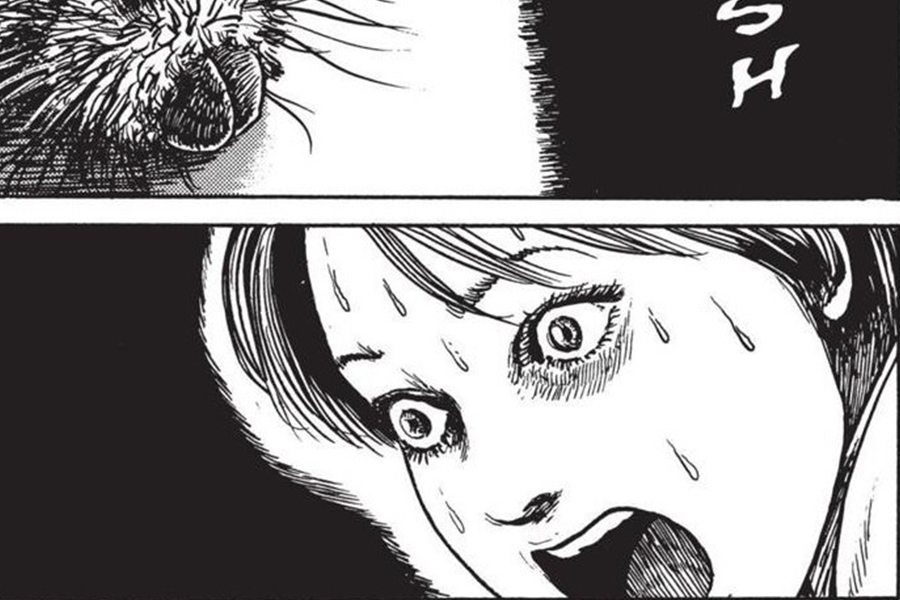Junji Ito Returns with Haunting “Tombs”
And other horror standouts from the chilling writer-artist
Credit: Junji Ito/Viz Media
Ito shows off his mastery of the human face in a panel from “Honored Ancestors.” What has frightened our protagonist so? No spoilers!
May 12, 2023
For all that I’ve read, nothing compares with the feeling of curling up under the covers, cracking open a hardcover, and scaring myself out of sleeping that night. The experience of reading horror is unique. No other medium can match the way suspense slowly builds as your eyes creep slowly across the page. I’m always on the lookout for new frights, so this past year, I’ve found myself sucked into a veritable treasury of literary excitement in the work of Junji Ito.
Ito is a Japanese graphic storyteller known for his outstanding horror manga, which range from bare-bones one-shots to sprawling novels. Although there are, in fact, multiple authors of horror manga, Ito’s work is probably the most widely translated and consequently the best-known in the West. While I would like to see more authors represented over here, I enthusiastically believe that Ito’s popularity is well-deserved. He has an excellent grasp of both the written and visual sides of comics, and wields it like a razor to create impeccable horror. He’s incredibly versatile as well, with work that ranges from artfully nasty splatter horror (“Lovesickness” and “Tomie”) or Sam Raimi-esque funny-scary (“The Strange Hikizuri Siblings,” the Soichi stories) to the philosophical and almost poignant (“The Long Dream,” “Gentle Goodbye”) and vicious, nail-shredding suspense (“The Enigma of Amigara Fault”). Inspired by the recent English release of his collection “Tombs,” I’d like to recommend a few standouts from his copious body of work, as determined by my subjective (but definitely correct) opinion, in the hopes of pulling you in along with me.
“Smashed”
This is one of several short story collections selected and published by Viz Media (as most English translations of Ito’s work are). It was my first encounter with his art, and I was an instant convert. Out of all the collections I’ve read, I think “Smashed” does the best job of showing off Ito’s range, with the tone swinging from the otherworldly weirdness of “Library Vision” and the dark, cackling humor of “Soichi’s Beloved Pet” to the slow, unbearable dread of “Earthbound” and the grisly, twisty, terrifying mélange of the title story while always maintaining the perfect horror atmosphere. “Smashed” is available at the WAHS library, and I would highly recommend checking it out.
“Tombs”
I could hardly get away with writing this article without discussing the publication that prompted it. “Tombs” brings together for the first time English translations of several of Ito’s more obscure works, and I must say, the proper, right-to-left, ink-and-paper experience is far superior to shady Imgur scanlations. A few subpar stories drag at the atmosphere a bit. Particularly, “Clubhouse,” the story of a group of student radicals who split their meeting house over a feud, starts out strong but then stumbles towards a rather sudden and mediocre ending. But despite its occasional missteps, the majority of “Tombs” is steeped in classic Ito scares. Lovecraftian homage seeps through the pages like sea salt and rot in “Drifted Ashore,” and “The Bloody Tale of Shirosuna” still gives me the same chills I got when I first found it as a badly-flipped PDF pirated by a commenter on a defunct horror blog. I was really blown away, however, by “Floaters.” This criminally underrated short is creepy, psychological, disturbingly human and distinctly Ito in the best possible way. Without spoiling it, it’s a very simple and yet incredibly original story that makes full use of Ito’s toolbox: the studies of the human face, raw emotion, twists and turns and awful revelations. I was hesitant to mention this collection at first, as it isn’t easily obtainable locally, but I feel confident recommending “Tombs” for those who can spare some money or wait a few months for it to hit the shelves.
“Uzumaki”
While “Uzumaki” is likely the best-known of Ito’s writing, it is my personal belief that it needs to be known even better. Titled by the Japanese word for spiral (because Viz knows their core audience won’t buy anything that doesn’t give them a chance to mutilate the Japanese language), this novel follows Kirie and her boyfriend Shuichi as they watch their isolated hometown descend into madness and violence, sucked into the haunting pattern of the spiral. The hypnotic shape slowly begins to warp every facet of life in Kurouzu-cho, giving Ito the perfect chance to show off his art skills. The stark, black-and-white illustrations are simple and readable, so when the spiral surfaces, it is terrifyingly clear exactly what is happening. Ito’s composition is outstanding as well. He knows exactly how to draw the reader’s eye, pulling it around and around and down into the twisting heart of his horror. “Uzumaki” is a captivating sprawl of insanity and nightmare logic that every current and future Ito fan should read.
“Venus in the Blind Spot”
Another short story collection, “Venus in the Blind Spot” is rather underrated despite containing some of Junji Ito’s best work. The crown jewels of this collection are the notorious “Enigma of Amigara Fault,” considered by many to be Ito’s scariest work; and the less famous but equally horrifying “Billions Alone,” which is one of my personal favorites. The collection also features graphic adaptations of “The Human Chair” and “Unearthly Love,” by the Japanese suspense writer Edogawa Ranpo, elevated to a new level of terror by Ito’s art. Some of the stories fall flat; I was a little let down by the titular short. Ito never falls short for a lack of ideas, and indeed, “Venus in the Blind Spot” (the short story) begins with a fascinating premise, but like “Clubhouse,” the plot that follows fails to build up enough suspense to pack the same horror punch as the rest of the collection. However, it’s a testament to the excellence of “Venus in the Blind Spot” that I hardly noticed the missteps of the titular story for the chilling masterpieces that surround it.









